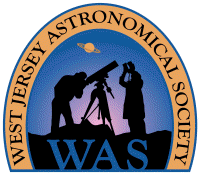| Weather Links |
Mercury 2024 last
sighting September 20 |
Lunar X
|
Omega Centauri |
Barnard's Star
|
Bald Eagles |
T CrB |
Comet C/2023 A3 (Tsuchinshan-ATLAS)
October 19, 2024
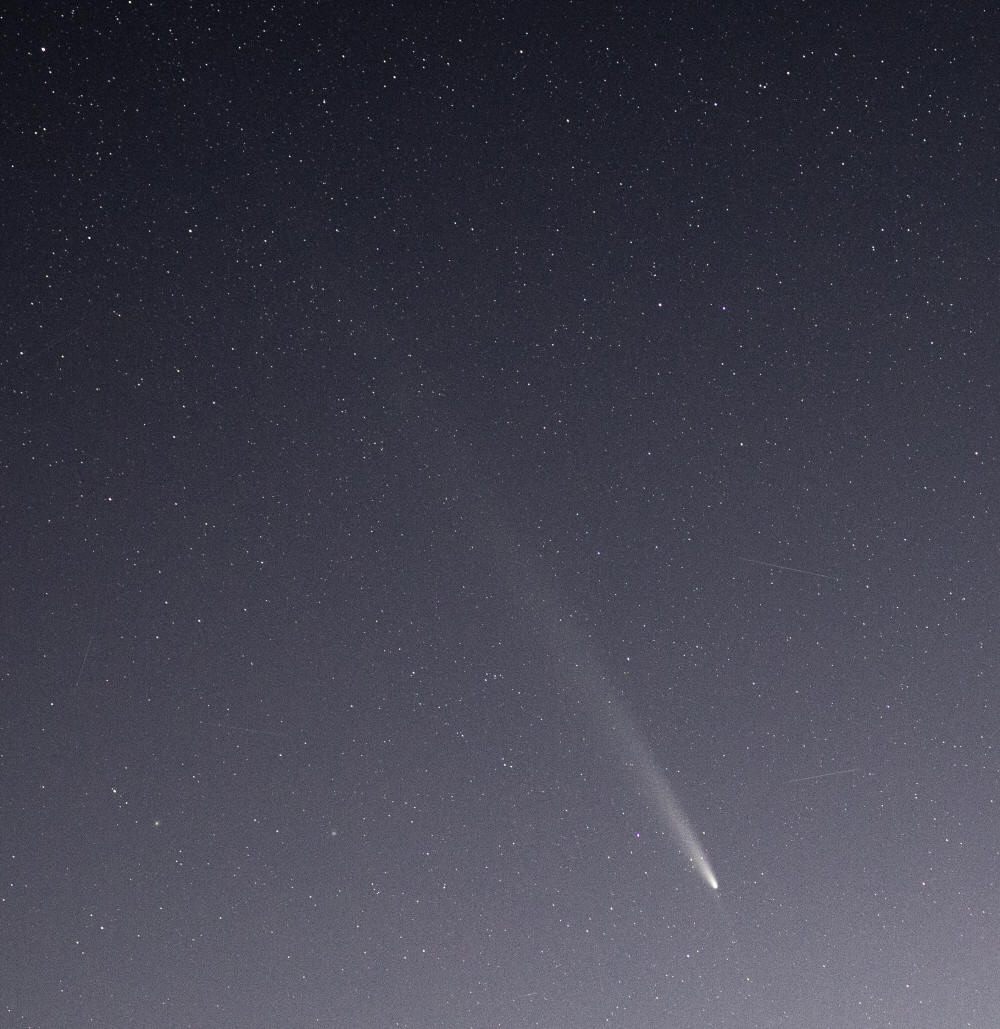
Comet C/2023 A3 (Tsuchinshan-ATLAS)
October 14, 2024
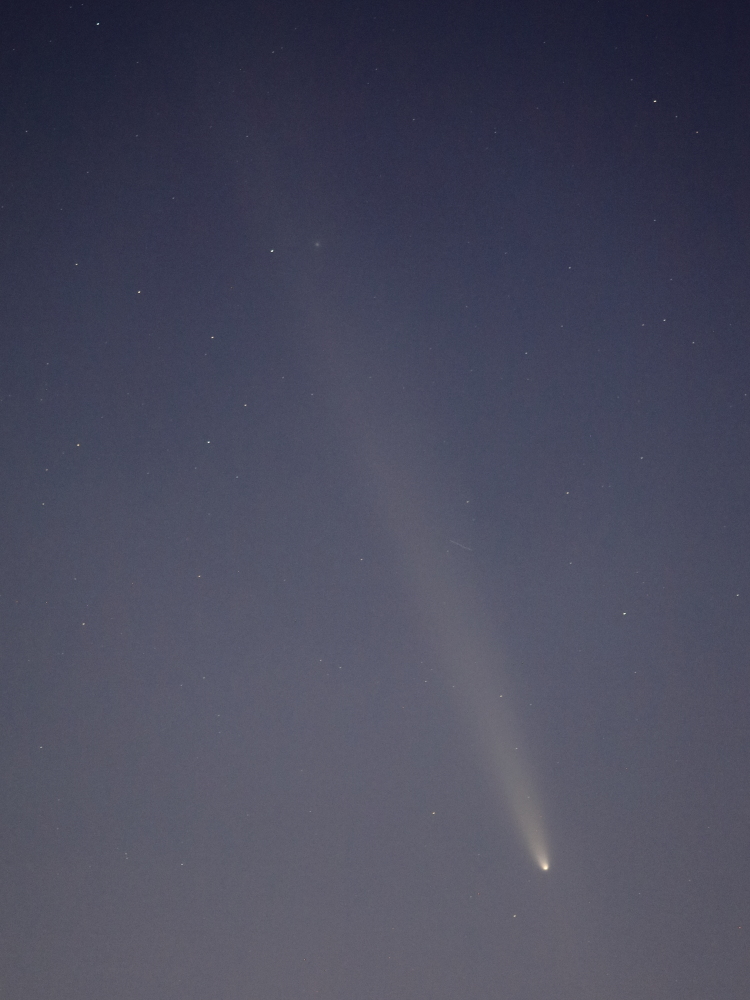
|
On
October 14, 2024, the sky cleared by sunset, so I went to Bishops Gate in Mt
Laurel to attempt to observe comet
C/2023 A3 (Tsuchinshan-ATLAS). It was first sighted with
12x50 binoculars at 6:59 pm EDT, 38 minutes after sunset at 6:21
pm and then with unaided eyes at 7:15 pm, including a visible
tail that extended upwards for a couple of degrees. It was also
observed with a 115 mm spotting scope at 35x. Clouds moved in as
the comet approached setting at 8:28 pm, and by 8:15 pm, it was
completely overcast to the west.
Here's a table of my further sightings that week.
This snapshot was taken at 7:27 pm with a Canon EOS RP
DSLM camera and a Canon 200 mm f/2.8L telephoto lens on a fixed
tripod. It's from a single raw frame exposed 1 second at f/2.8,
ISO 1600 and 5600 K white balance. It was mildly adjusted in
Canon's Digital Photo Professional then cropped to a field about
6° wide x 8° high. In this view, the tail is about 6° long. 5.5°
above the nucleus, the tail crosses the globular cluster,
Messier 5, next to the star 5 Serpentis. Mouseover for
labels. |
Aurorae
in Suburban New Jersey
October 10, 2024
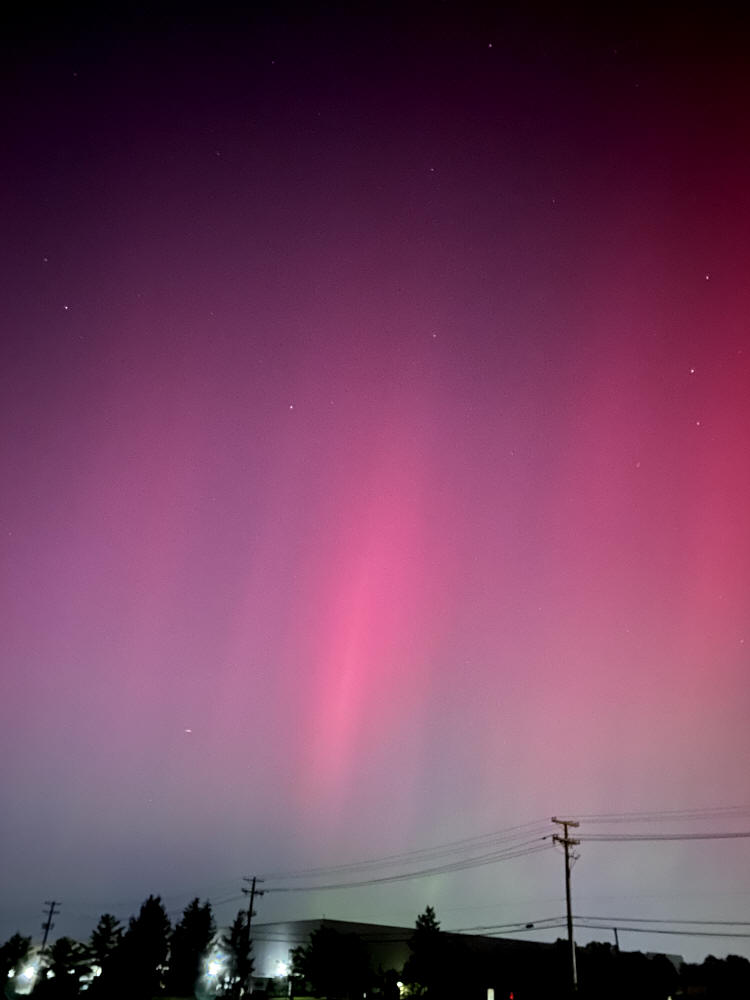
|
On
October 10, 2024, I went to Bishops Gate in Mt
Laurel to attempt my first sighting of comet
C/2023 A3 (Tsuchinshan-ATLAS) in the evening sky after solar
conjunction on October 9, but the solar elongation was only about 8°. Sunset
was at 6:27 pm EDT and I looked for it unsuccessfully between
6:25 and 7:00 pm with 15x56 binoculars and at 25x88 with a spotting
scope. I also looked for the extended tail of the comet from
7:00 to 7:15 pm unsuccessfully.
As I was finishing packing up, I turned around from the
car and looked to the west, the approximate azimuth of the
comet, and was astonished to see a reddish glow in the sky -
aurora! I had seen the internet traffic
earlier in the day about the
possibility of aurora this evening, but I wasn't optimistic
about seeing anything (as if aurorae go out of their way to
avoid me; it's probably been close to twenty years since I've
seen any). Regardless, the reddish glow was easy to see, and I
ultimately saw some greenish color too, which shows much better in
the pictures than to the unaided eye. In the picture below, I
visually saw a pale gray patch, but in the smartphone's live
view, it was unmistakably green. The display lasted from about
7:20 until 7:45 pm. I then left, but came back and met with a
friend there around 9 pm. We hung around, and then just after 10
pm, I noticed a reddish patch to the west and we had some
more aurorae until nearly 11 pm, but not as intense as the first round
I saw earlier. Splendid nevertheless.
Both of these snapshots were taken with a handheld iPhone
11. The one above at 7:26 pm looking roughly north, the one
below at 7:29 pm looking roughly northeast. |
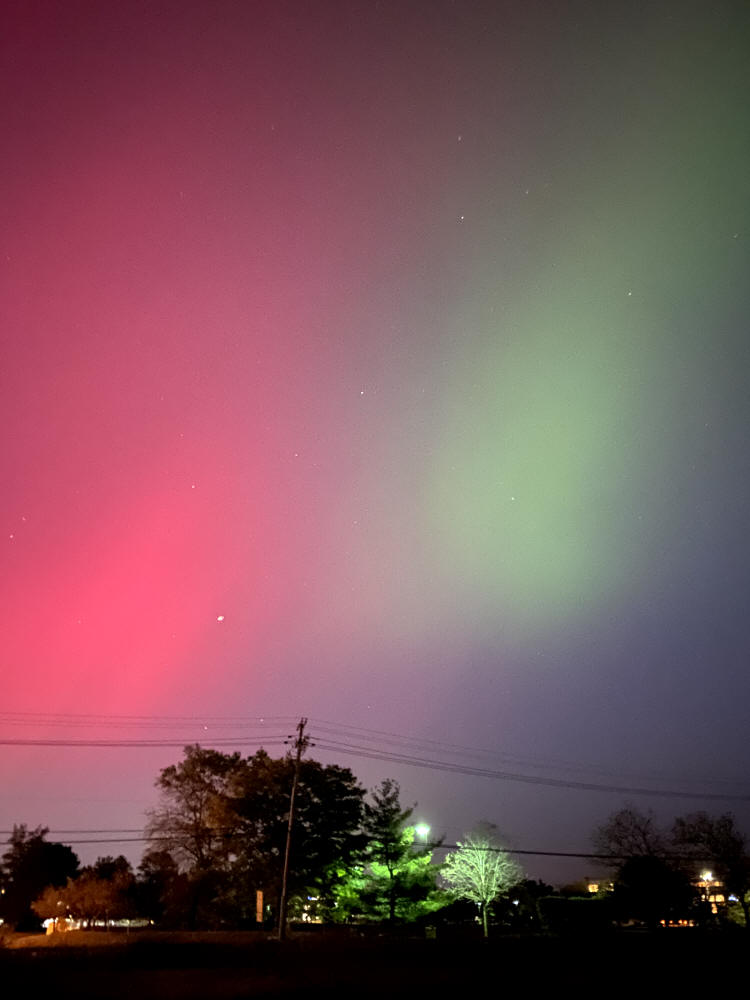
Comet C/2023 A3 (Tsuchinshan-ATLAS) — Not
October 6, 2024
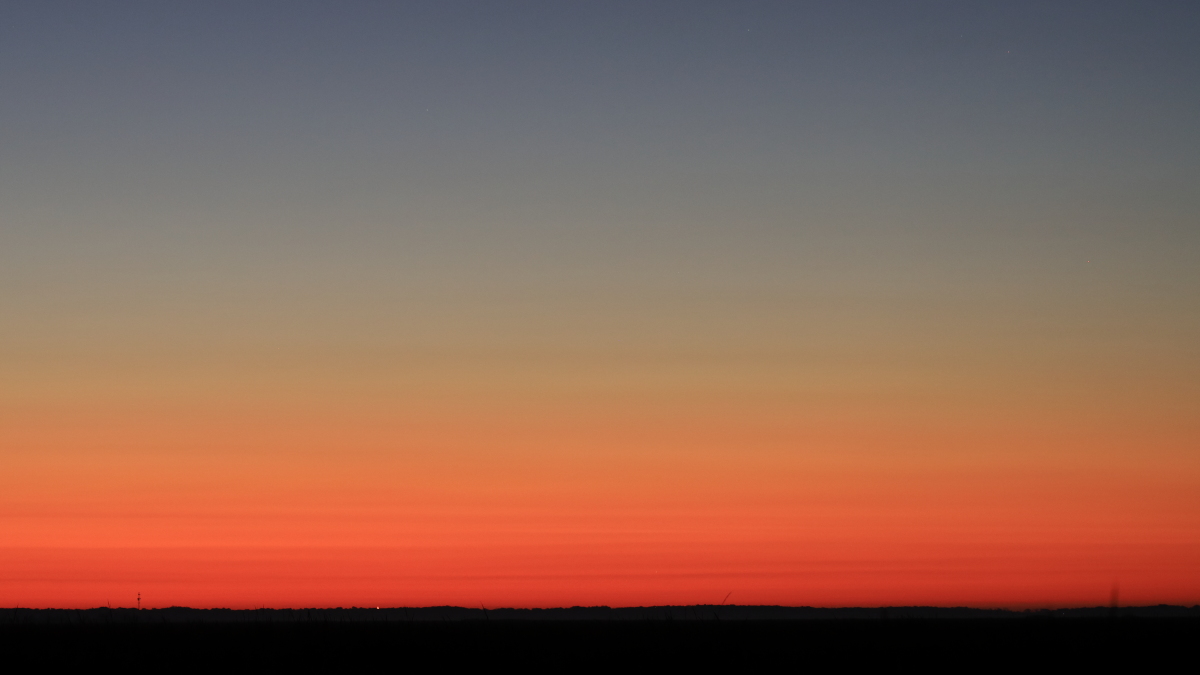
|
On
October 6, 2024, I made a dawn visit to the
observation platform parking lot at Thompson's Beach, NJ, hoping
to make a final sighting of comet
C/2023 A3 (Tsuchinshan-ATLAS)
before it reaches solar conjunction on October 9, then moves
into our evening sky. My last sighting was on the morning of
October 4 from Swede Run in Moorestown, NJ, a suburban location,
when the coma, with a strong central condensation and a stubby
tail, was spotted with 15x56 binoculars at 6:13 am, 16½° solar
elongation.
Thompson's Beach is a dark site (for New Jersey), and being in a
vast salt marsh, the horizons are quite low towards the east.
I've spotted rising Mercury and Venus at less than a degree
apparent altitude from this spot. When I arrived on October 6,
shortly before the start of astronomical twilight at 5:30 am
EDT, I was able to see Uranus, M35, M41 and M47 with unaided
eyes. However, even in the dark, I could see the all-to-familiar
streaky clouds along the eastern horizon.
This picture was taken at 6:18 am, 4 minutes after A3 rose
at 6:14 am and 47 minutes before sunrise. For reference, the red
dot (a distant antenna tower) at the top of the tree line left
of center is at 92° azimuth (as determined by stars visible in
an earlier picture taken when it was dark). The coma here would
have been about three-quarters of a degree altitude, 95° azimuth
and 11½° solar elongation, but it's masked by the streaky
clouds. There's also no sign of the extended tail (at least 10°
long) that would have been projecting up and to the right of the
coma. Neither the coma nor the tail were seen visually with
unaided eyes, 8x42 or 15x56 binoculars through 6:30 am.
Captured with a Canon EOS RP DSLM camera with a 100 mm f/2.8L
telephoto/macro lens on a fixed tripod. Exposed 1/4 second at
f/4.0, ISO 800, automatic white balance. It's a single raw frame
unprocessed, other than cropping to a 16:9 ratio using 77% of
the width and 65% of the height for a field 15.7° wide x 8.9°
high, then converting to this JPEG with Canon's Digital Photo
Professional 4. |
Foggy Mercury & Regulus
September 11, 2024
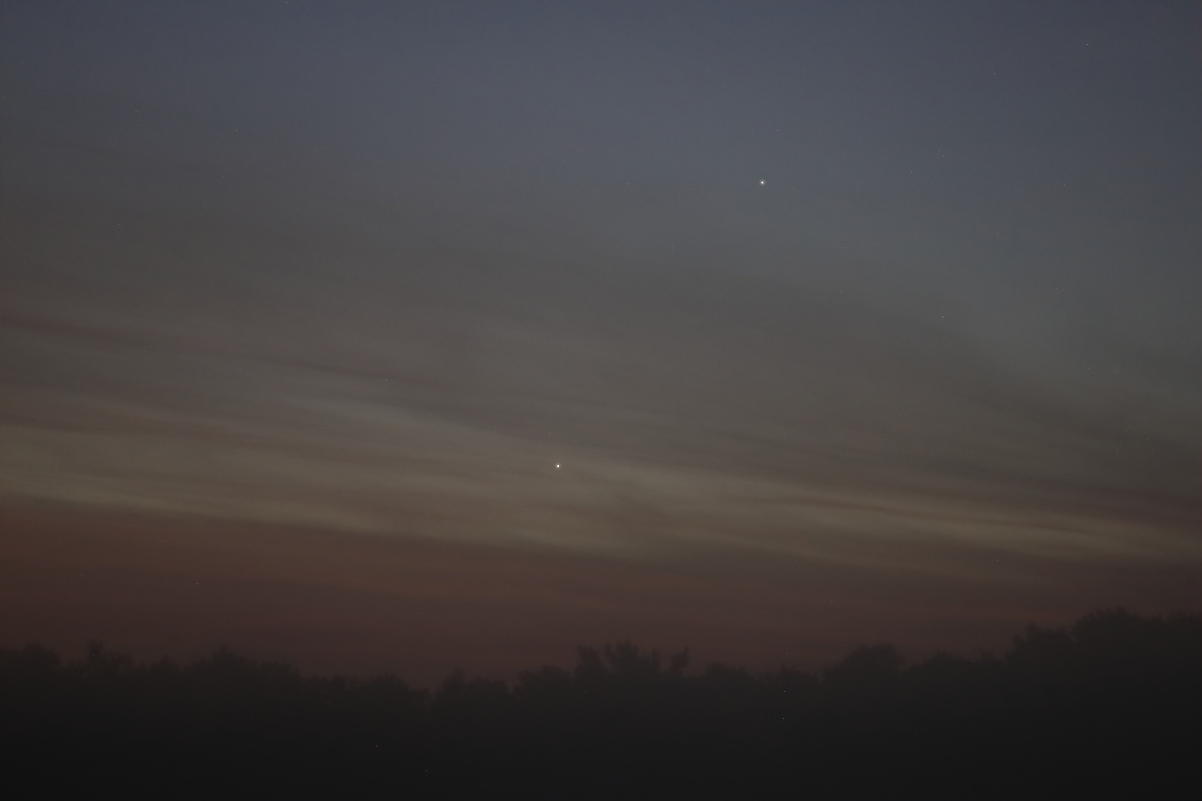
|
On
September 11, 2024, the swift-moving planet
Mercury was 3.1°
from the first-magnitude star Regulus, Alpha Leonis
(mouseover for labels). This
image was captured at 5:38 am EDT from Swede Run in Moorestown,
NJ, when Mercury was at 3.9° altitude, shortly
after rising in streaky clouds and as seen through ground fog
during morning twilight, which began at 5:05 am EDT; sunrise
would be at 6:37 am. Taken with a
Canon EOS RP DSLM camera and a Canon 200 mm f/2.8L telephoto lens
on a fixed tripod. This single raw frame was automatically
exposed 1.6 seconds at f/2.8,
ISO 1600 with auto white balance. It was slightly adjusted with
Canon's Digital Photo Professional 4 and not cropped for a field
10.3° wide x 6.9° high. Spotting Mercury (initially with 12x50
binoculars and later with unaided eyes) completed an overnight
seven-planet sighting sweep. |
Polaris Dawn Launch
September 10, 2024
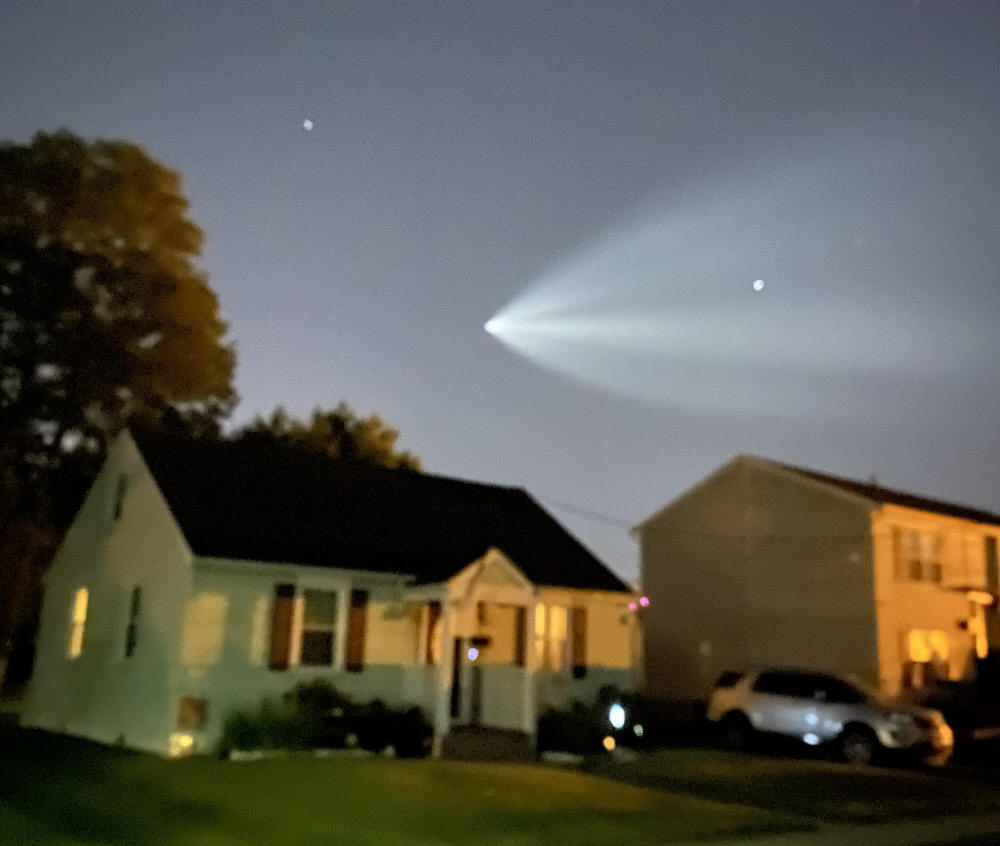
|
On
September 10, 2024, SpaceX launched their
Polaris Dawn mission from Kennedy Space Center in Florida,
lifting off at 5:23 am EDT. Since the launch trajectory
headed northeast off the coast of the eastern USA, it was
visible as from southern New Jersey as it passed, although I
wondered if astronomical twilight starting at 5:04 am would have
a deleterious effect; it didn't. I watched from the street in
front of my home in Maple Shade, NJ, and first spotted the
massive and spectacular rocket plume at 5:29 am. It had nine
"arms" that aren't clearly differentiated in this blurry photo
that I took at 5:32 am with a handheld iPhone 11 looking
southeast. The two stars in it are Procyon (left) and Sirius
(right), about 26° apart, so the visible plume is on the order
of 25° long. Taking that angle and assuming the
rocket was 300 miles away, the small angle approximation yields a physical length of about 130 miles for the visible
plume. The rocket exhaust and the plume
abruptly faded
at 5:33 am. Moments later, the second stage ignited, with the
rocket exhaust then sporting a single modest trailing arm and
paraboloidal plume; all of this, the rocket exhausts and the
plumes from both stages were whitish in color (as opposed to the
orange rocket exhaust of a Falcon 9 second stage seen on August
28 taking a batch of Starlink satellites to orbit). It was a
most spectacular view!
Here's another picture at the Spaceweather
Photo Gallery. |
The Young Crescent Moon and Venus
September 5, 2024
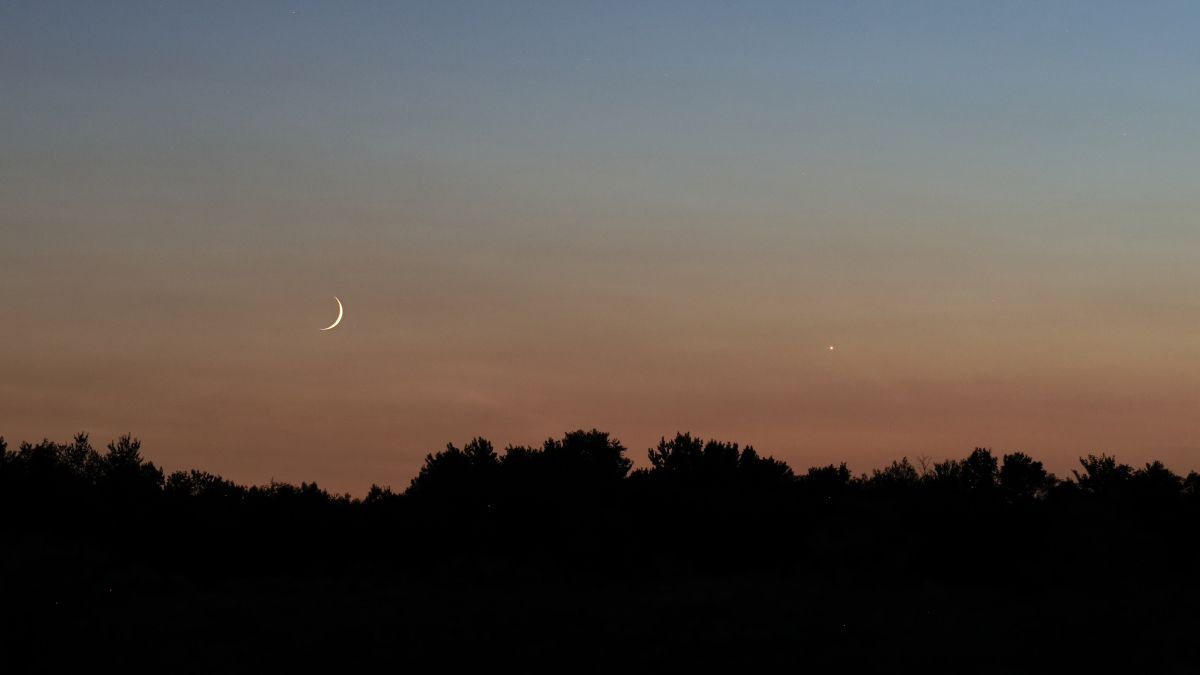
|
On
September 5, 2024, the young
Crescent Moon
joined the planet
Venus as they
approach the tree line on the western horizon after sunset as seen from
Bishops Gate in Mt Laurel, NJ. Venus was
at superior conjunction on June 4, 2024, while the Moon new at
9:56 pm EDT on Sept 2, so it was nominally 2.9 days old and 7.3%
illuminated. This is the view at 8:06 pm when the Moon was at
4.0° altitude, Venus was at 3.6° altitude, and the pair was 6.6°
apart (center-to-center). Taken with a
Canon EOS RP DSLM camera and a Canon 100 mm f/2.8L
telephoto/macro lens on a fixed tripod. This single raw frame was automatically exposed 0.4 seconds at f/5.6,
ISO 1600 with auto white balance. It was lightly adjusted with
Canon's Digital Photo Professional 4 and cropped to a 16:9 ratio for a field
16° wide x 9° high. Venus was slightly
enhanced with Adobe Photoshop Elements. Mouseover for
labels. |
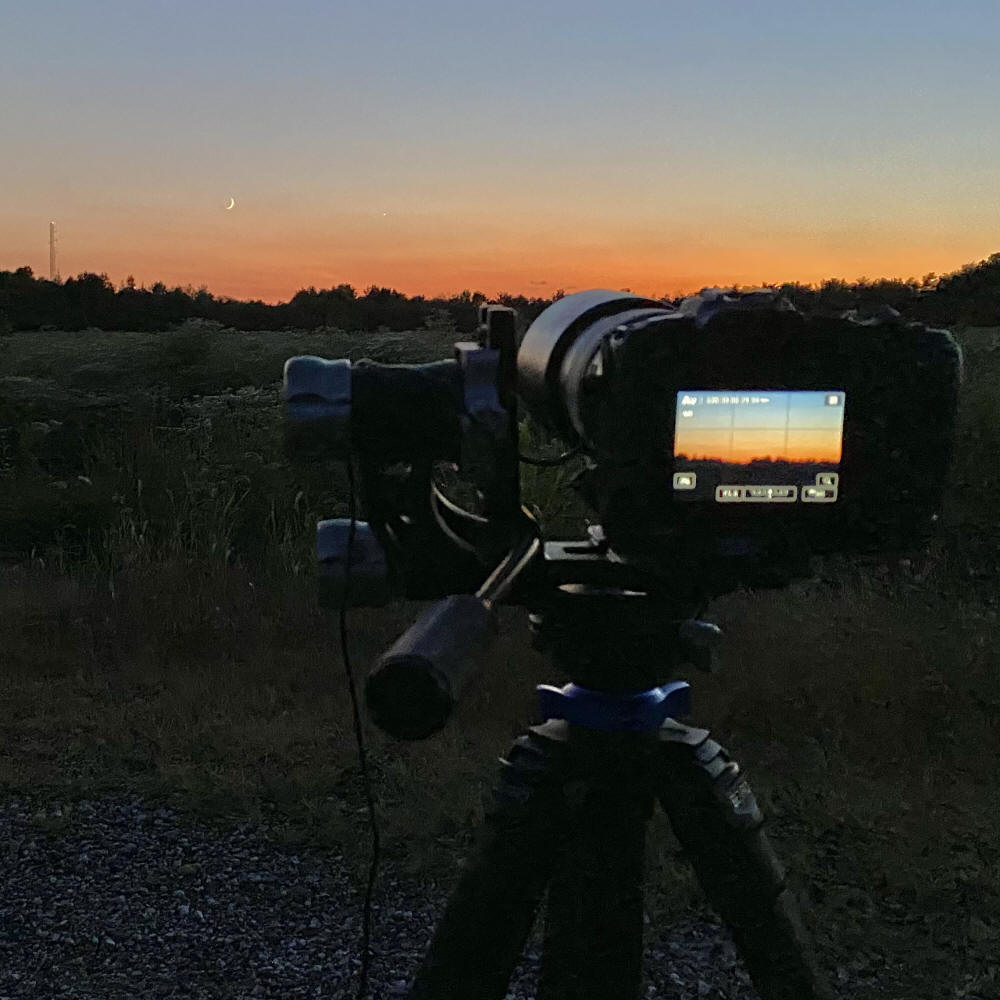
|
Here's the camera setup used on
September 5, 2024, to take the preceding
picture. It's the Canon RP DSLM camera, which being
mirrorless, normally has the current view when the rear screen
is flipped outwards (no need for live view mode like a DSLR). It
was attached to a Canon 100 mm f/2.8L telephoto/macro lens,
which in turn was mounted on a FotoPro gimbal head, featuring a
tilting arm for access to higher elevations. All of this rides a
substantial Benro carbon fiber tripod. An electrical remote
shutter release dangles from the mount.
Taken with a handheld iPhone 11 at 7:56 pm EDT. Exposed 1/30
second at f/1.8, ISO 800. The Moon can be seen in the
background, and with difficulty, Venus too. The antenna on the
left is at NJ Turnpike Southern Division Maintenance HQ (the NJ
Turnpike is just behind the distant trees). The NJ State Police
Troop D Moorestown Station is next the maintenance yard. |
The Young Crescent Moon
September 5, 2024
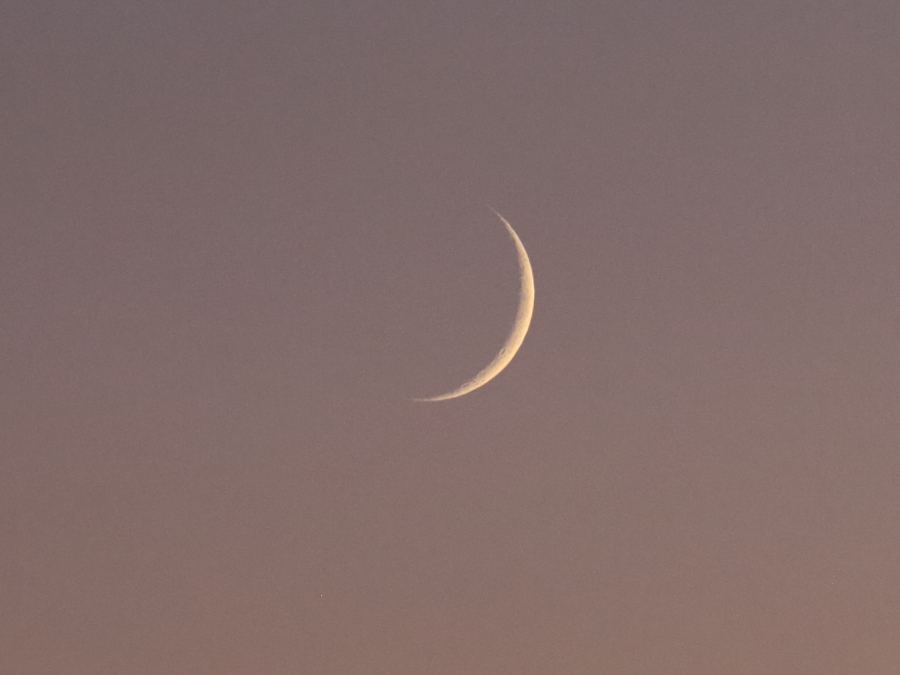
|
On
September 5, 2024, before taking a wider field
picture of the Crescent Moon and Venus as seen above, I also
captured the Moon
itself using the same rig, except with a Canon 400 mm f/5.6
telephoto lens. This single raw frame was captured at 7:45 pm,
exposed automatically 1/125 second at f/8.0, ISO 3200, auto
white balance. It was minimally processed in Canon's Digital
Photo Professional 4 and cropped to a 4:3 ratio using 38% x 43%
of the original length x width. The resultant field is 2.0° wide
x 1.5° high. |
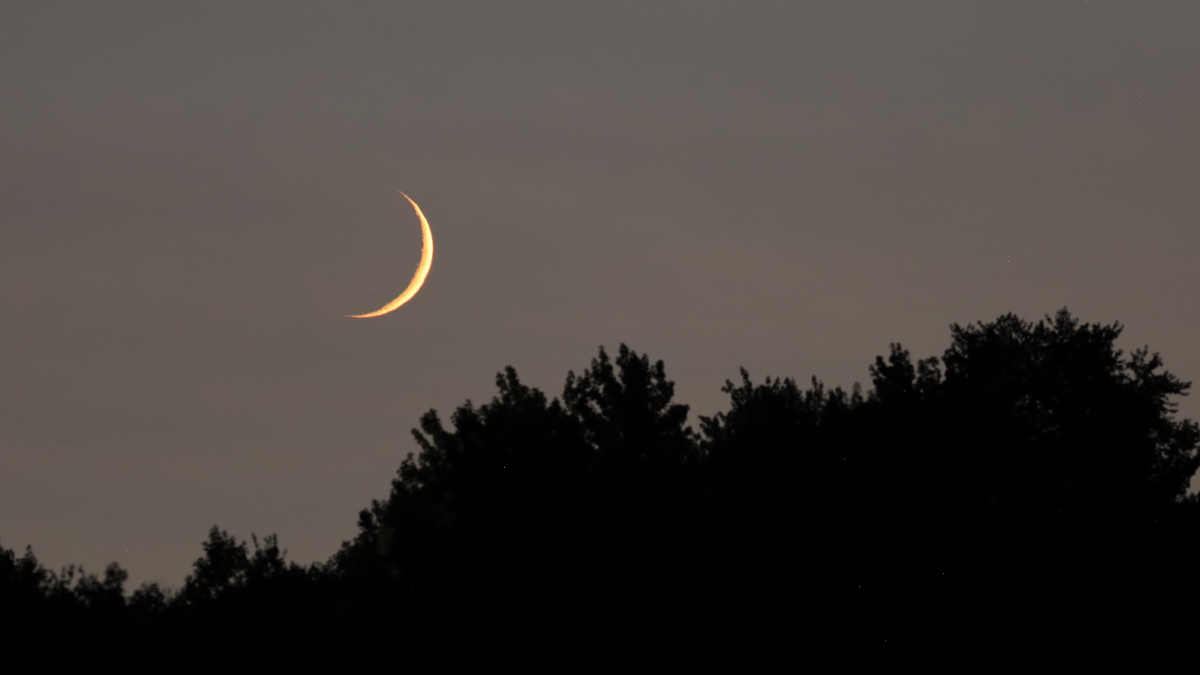
|
On
September 5, 2024, this is the final shot of the
crescent Moon
before it sank behind the distant trees. Again, the same rig
with the Canon 400 mm f/5.6 telephoto lens. This single raw
frame was captured at 8:13 pm, exposed automatically 0.8 seconds
at f/5.6, ISO 1600, auto white balance. It was minimally
processed in Canon's Digital Photo Professional 4 and cropped to
a 16:9 ratio using 77% x 65% of the original length x width. The
resultant field is 4.0° wide x 2.2° high. |
Smoke at Carranza
September 3, 2024
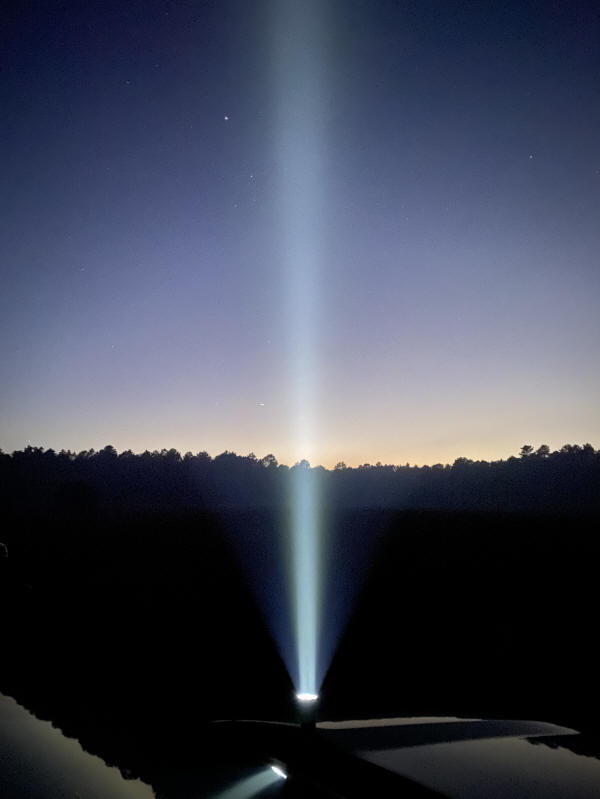
|
On
September 3, 2024, I went to Carranza Field in
Wharton State Forest, NJ, mainly to look fort comet 13P/Olbers.
However, on the way down Carranza Rd, I smelled wood smoke and
saw light beams from the headlamps. When I arrived at the field,
it was shrouded by bluish smoke that again smelled like burning
wood. No fires were visible from the field and I never found
reports of a nearby fire. Evidently, the winds that day blew in
the smoke from an unknown, more distant place.
The picture shows an LED flashlight (on low power) aimed upwards
while standing in the windshield wiper well of my car. The
reflection is off the car's windshield. Taken with a handheld
iPhone 11 at 8:25 pm EDT. The star near the top is Arcturus. |
Venus from Thompson's Beach
August 22, 2024
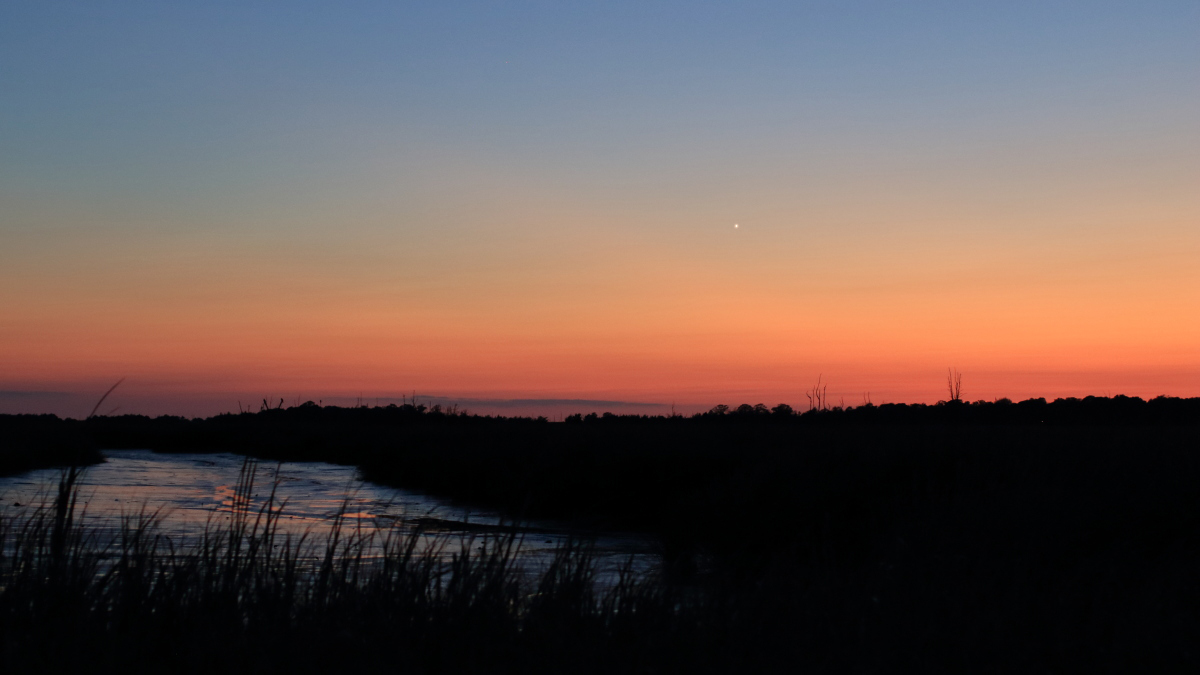
|
On
August 22, 2024, the planet
Venus was low and
sinking towards the western horizon after sunset as seen from
the Thompson's Beach, NJ, nature observing platform. Venus was
at superior conjunction on June 4, 2024 and has been slowly
gaining altitude after sunset as it creeps away from
the Sun. At the time of this picture, 8:17 pm EDT, 31 minutes
after sunset at 7:46 pm, Venus was at 4.6° altitude, 272°
azimuth and 21.6° solar elongation. The shallow inclination of
the ecliptic at sunset this time of the year, about 29° with
respect to the horizon, is a major factor in Venus's slow climb;
much of the elongation is sideways rather than vertical.
Nevertheless, Venus' brightness, now magnitude -3.9, allows it
to be seen relatively easily after sunset. It was first spotted
on August 22 at 7:50 pm with 12x50 binoculars, then once located,
it was seen with
unaided eyes. By 8:10 pm, it was easy with unaided eyes. The
Moon was observed breaking the horizon shortly after it rose at
9:39 pm, see below.
Taken with a handheld Canon EOS 7D Mk II
DSLR camera (APS C sensor) and a Tamron 45 mm f/1.8 lens. It was
automatically exposed 1/60 second at f/2.8, ISO 1600 with auto
white balance. It was lightly adjusted with Canon's Digital
Photo Professional 4 and cropped to a 16:9 ratio (keeping the
full width) for a field 28° wide x 16° high. Venus itself was lightly
enhanced with Adobe Photoshop Elements. Mouseover for labeling. |
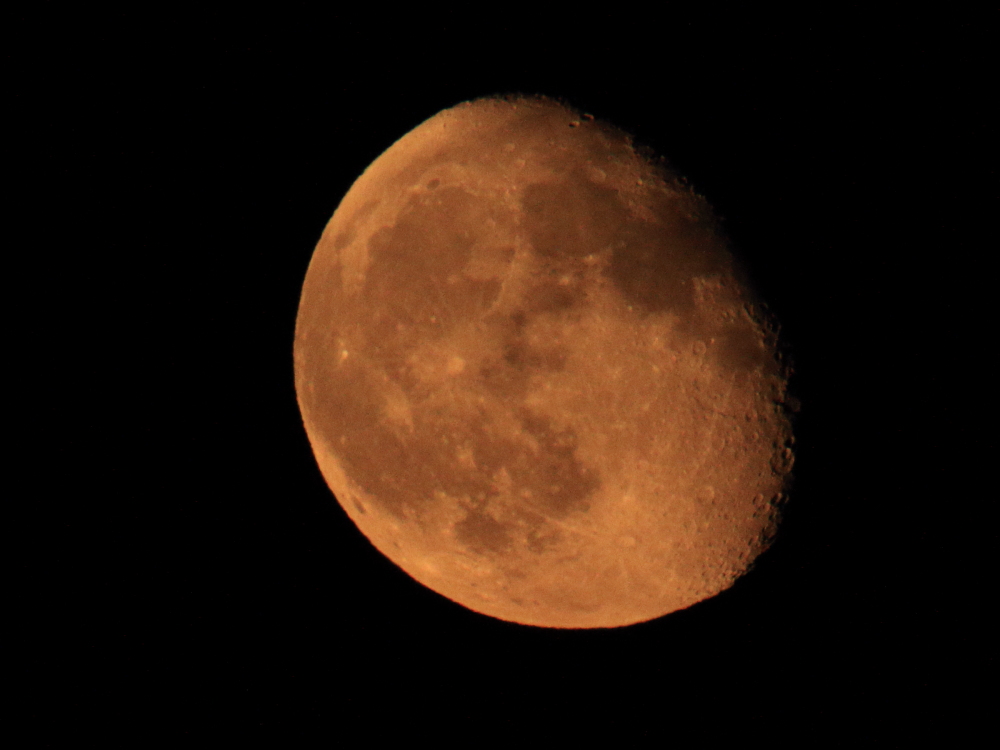
|
This image of the rising
Moon was captured on
August 22, 2024, from Thompson's Beach, NJ, not
long after it rose at 9:39 pm. At the time, it was 84%
illuminated and 4.5° altitude. Visually, it did indeed have this
orange hue from differential absorption due to the thick
atmosphere at that low altitude (blue attenuated more than
red) and there's a little atmospheric prismatic chromatic
aberration (a greenish tinge at the upper limb, a reddish tinge
at the lower limb).
This snapshot is from a single raw frame taken at 9:56 pm EDT
with a Canon EOS 7D Mk II DSLR camera and a Tamron 150 to 600
mm, f/5.0 to 6.3, telephoto zoom lens (on a fixed tripod) set to 600 mm
focal length. It was exposed 1/320 second at f/11, ISO 3200,
daylight white balance (about 3.3 stops less than the
Looney 11 rule of thumb for lunar exposure). Except for a
slight reduction in color saturation in Canon's
Digital Photo Professional 4, it is unadjusted. It was cropped
to a 4:3 ratio, 44% x 49% of the original linear dimensions,
yielding a
field about 0.9° wide x 0.7° high, then saved as this 1000 x 750
JPEG, in DPP4. |
Jupiter, Mars and Uranus
August 15, 2024
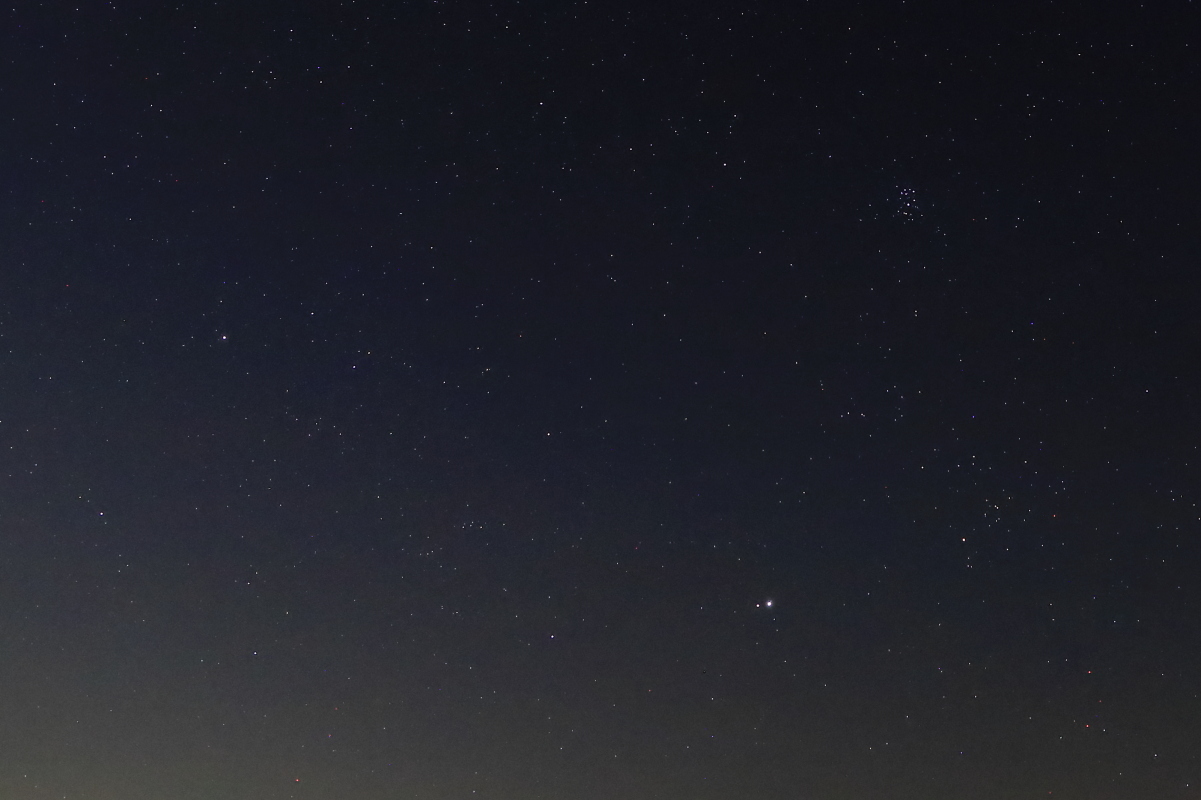
|
On
August 15, 2024, the planets
Jupiter and
Mars were separated by 27 arc minutes, a
day after they were in conjunction on August 14 and just 20 arc
minutes apart in our New Jersey pre-dawn sky. The planet
Uranus is also
present here, near the Pleiades star cluster. Taken at 3:11 am
EDT from Carranza Field in Wharton State Forest, NJ.
It's from a single raw frame captured with a Canon EOS RP DSLM
camera (on a fixed tripod) and a Sigma 20 mm, f/1.4 Art lens. It was exposed 2 seconds at f/2.0, ISO
3200, auto white balance. Modest adjustments were made with
Canon's Digital Photo Professional 4, then it was cropped to 51% of the
original linear dimensions providing a
field about 49° wide x 34° high.
Mouseover for labels.
On the morning of August 14,
2024, I observed Jupiter and Saturn
from my front yard in Maple Shade, NJ, with my Kowa 88 mm apo
spotting scope. They both fit in the same field at 96x. I also
looked at Uranus in the spotter. The shift in position angle
between Jupiter and Mars,
mainly due to Mars' movement east, is
obvious between the image from August 13 below and August 15
above. |
Jupiter & Mars with the Hyades
August 13, 2024
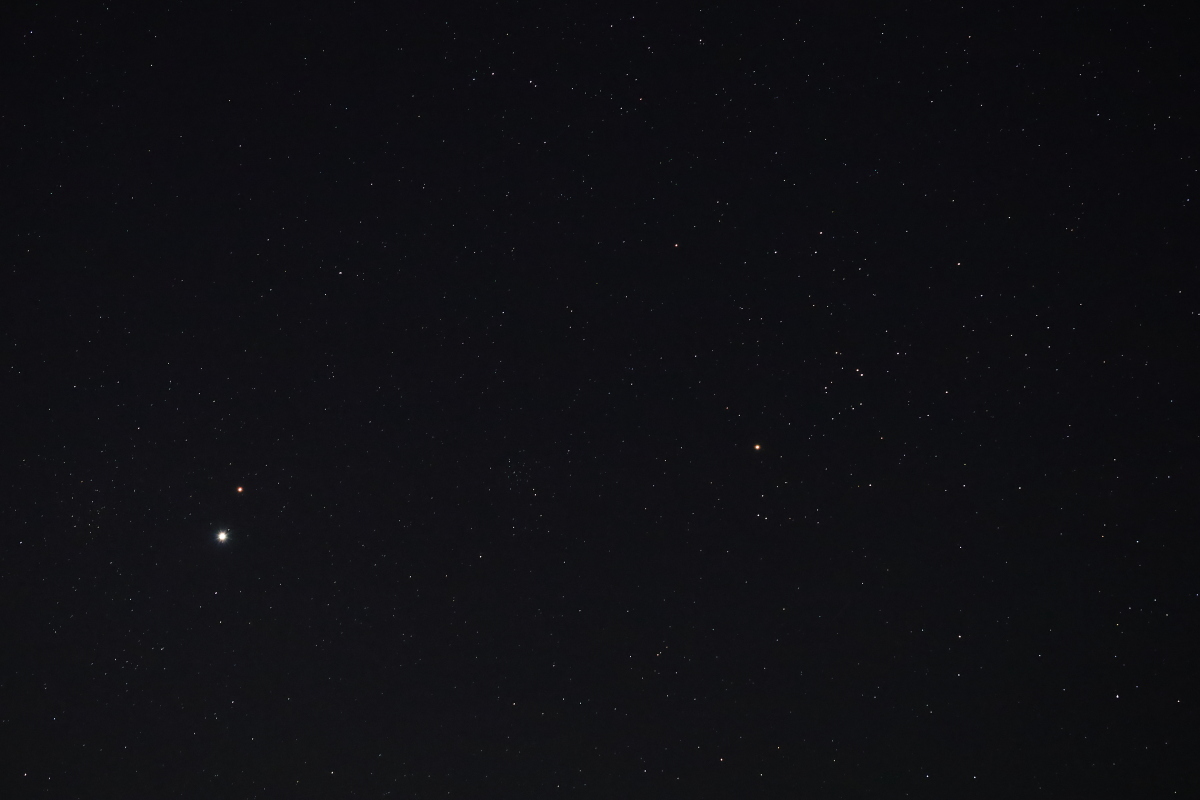
|
On
August 13, 2024, the planets
Jupiter and
Mars were just 44 arc minutes apart in the pre-dawn sky
as seen from Carranza Field in Wharton
State Forest, NJ. The two planets will be at formal
conjunction
in geocentric right ascension on August 14 at 1 pm EDT, but
towards dawn, they'll be just 20 arc minutes apart.
This snapshot of them, looking roughly east around 20° altitude,
is from a single raw frame taken at 2:58 am EDT with a Canon EOS
RP DSLM camera and a Canon 100 mm, f/2.8L macro lens on a fixed
tripod. It was exposed 3.2 seconds at f/4.0, ISO 6400, 4200K
white balance. Modest adjustments were made with Canon's Digital
Photo Professional 4, and it was cropped to 87% of the original
linear dimensions providing a
field about 18° wide x 12° high.
Mouseover for labels.
Here's a heavy crop, using 19% of the original linear
dimensions of the same raw image as above, providing a field
4.0° wide x 2.6° high. It magnifies the field around Jupiter and
Mars showing the Galilean satellite Callisto outside the glare
of greatly overexposed Jupiter (it's just visible with close
inspection of the version above). Solar system objects are
labeled in yellow, along with their magnitude values, as well as
magnitude values for selected stars shown in blue (all
magnitudes are from SkyTools). |
Jupiter, Mars & Uranus with the Pleiades & Hyades
July 27, 2024
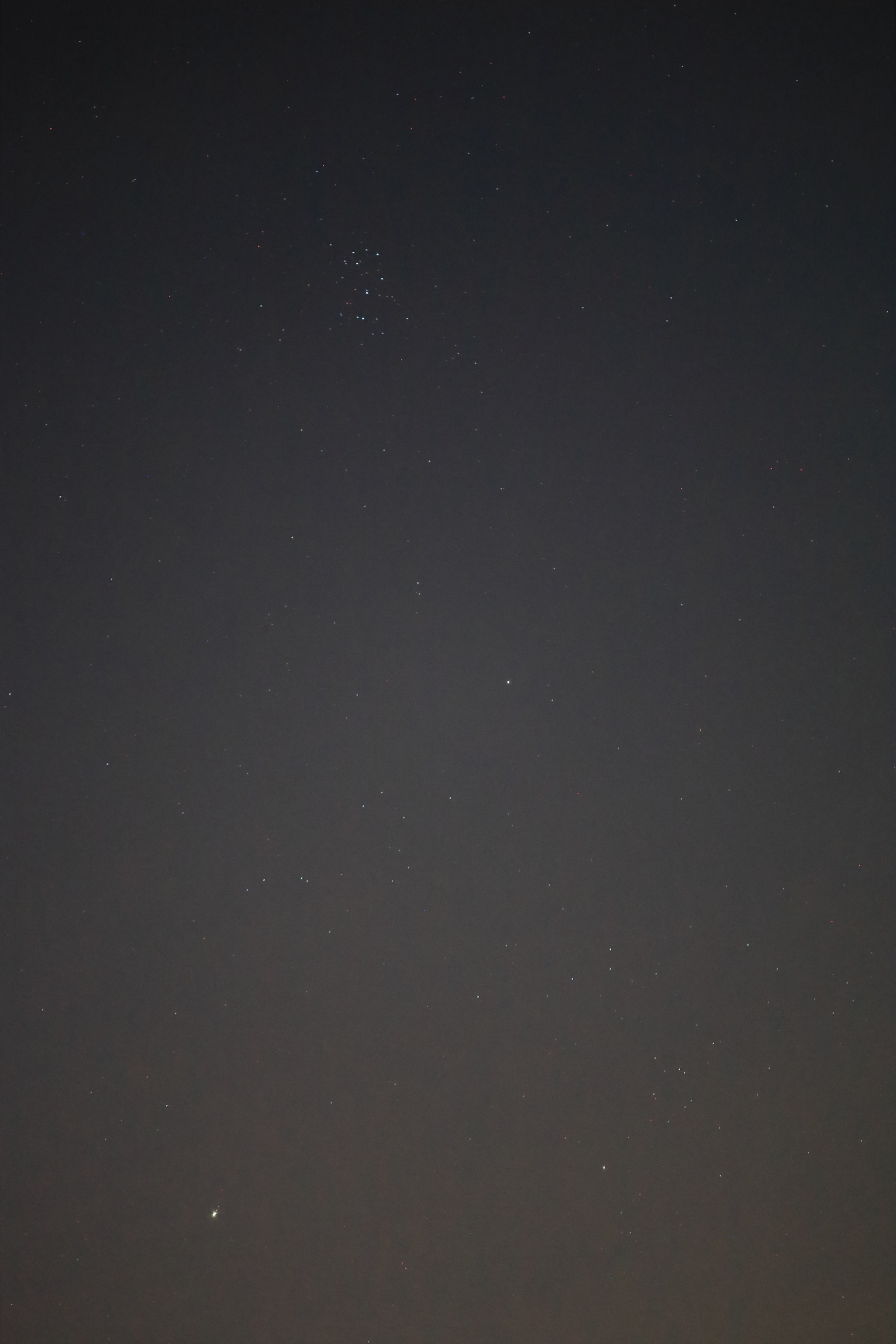
|
This image with the planets
Jupiter,
Mars
and
Uranus near
the
Pleiades and
Hyades star
clusters, all in the constellation
Taurus, was captured on
July 27, 2024, from Marter Avenue in Mt Laurel, NJ.
The 59% illuminated gibbous Moon was about 32° east of Uranus,
resulting in some glow to the background sky. This
was mainly intended as a test image to check the field of view of the
camera-lens combination as shown by SkyTools and SkySafari (it
matched). On
the morning of July 30, 2024, the 27% illuminated crescent Moon
will form a compact triangle with Mars and the Pleiades, to the
left of a line between them (here's a
SkySafari screen capture of this alignment). By then, Mars will have moved about
2° eastward, down and to the left in this view (for reference,
it's about 3.2° between the stars Ain and Aldebaran in the
Hyades). On August 14, 2024,
Jupiter and
Mars will be in conjunction, about 0.3° apart. Mouseover for labels.
This snapshot is from a single raw frame taken at 3:31 am EDT with a
Canon EOS RP DSLM camera and a Canon 100 mm, f/2.8L macro lens on a
fixed tripod. It was exposed 0.8 seconds at f/2.8, ISO 3200,
automatic white balance. Very mild processing was applied with Canon's
Digital Photo Professional 4. It was not cropped yielding a
field 13.7° wide x 20.4° high. The camera was rotated about 15°
clockwise from a vertical orientation to fit all the objects
inside the frame.
If magnified and examined closely, the Galilean satellites of
Jupiter can be seen. The picture below, taken at 3:27 am with
the same equipment, but exposed 1 second at f/3.5, ISO 3200,
better shows those satellites. It was cropped to 400 pixels
square (10% x 6% of the original linear dimensions) for a field
1.3° square. Mouseover for labels. |
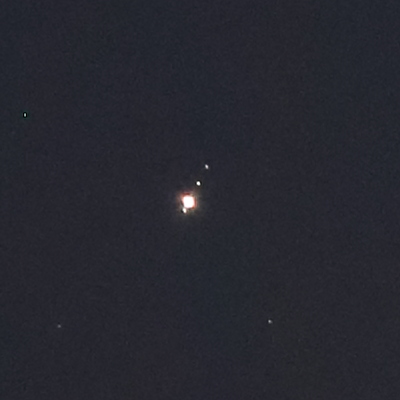
Mars, Uranus and the Pleiades
July 16, 2024

|
This image with the planets
Mars
and
Uranus near
the
Pleiades star
cluster, all in the constellation
Taurus, was captured on
July 16, 2024, from Carranza Field in Wharton
State Forest, NJ. The two planets were at formal
conjunction in
geocentric right ascension on July 15 at 5 am EDT and were at
their apparent closest to each other (appulse) at 10:28 am EDT,
32 arc minutes (0.53°) apart, but clouds precluded observing
yesterday morning. Since then, Mars has moved eastward (down and to the
left in this view) at a faster rate then Uranus. As a result of that
differential rate, and regardless of their current proximity, Uranus
reaches
opposition on November 16, 2024, but Mars won't until
January 15, 2025.
The stars labeled in the
upper right quadrant of the image (mouseover for labels)
were guides in recent years for finding Uranus quickly with
binoculars. Around 3:30 am, Mars (magnitude 0.9),
Jupiter (-2.1) and
Saturn
(0.9) were
visible with unaided eyes, while Uranus (5.8) and
Neptune (7.9) were visible
with 8x42 binoculars, despite the hazy sky. So, five of the
seven non-Earth planets were visible. Mercury and Venus are
visible after sunset now.
This snapshot, looking roughly east-northeast at 16 to 22°
altitude, is from a single raw frame taken at 3:22 am EDT with a
Canon EOS RP DSLM camera and a Canon 200 mm, f/2.8L telephoto lens on a
fixed tripod. It was exposed 2 seconds at f/2.8, ISO 6400,
tungsten white balance. Modest processing was applied with Canon's
Digital Photo Professional 4. It was not cropped yielding a
field 10.2° wide x 6.8° high.
Astronomical twilight would begin at 3:48 am.
Here's the alignment on July 19, 2024 (same exposure
settings). |
Fire in the Pines
Wharton State Forest, July 10, 2024
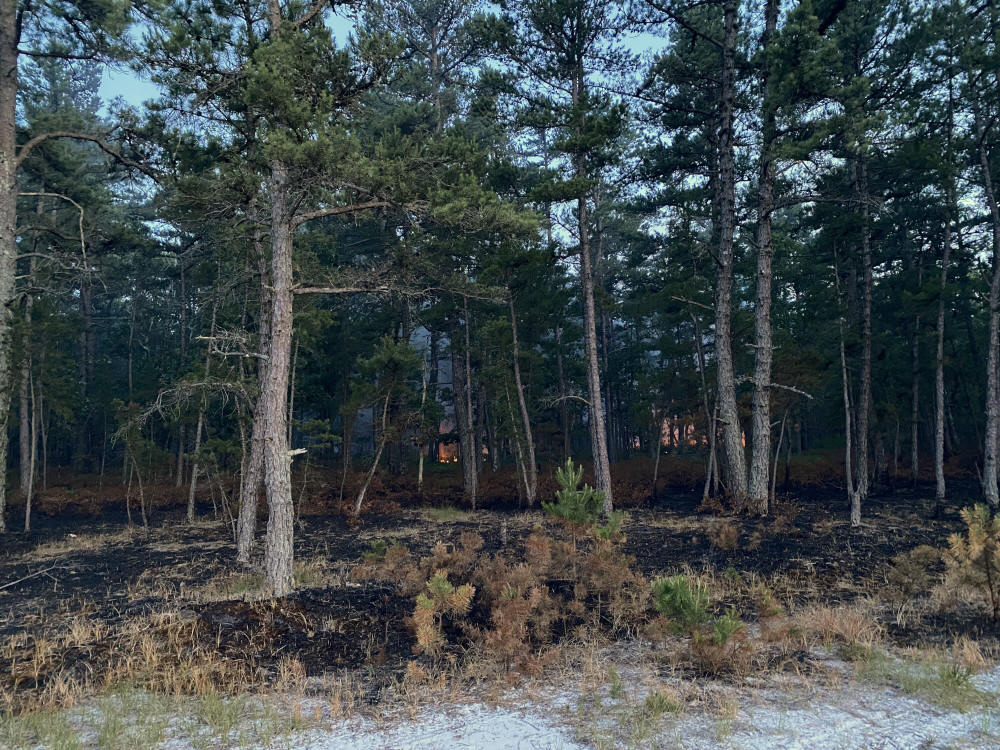
|
On
July 10, 2024, after
afternoon clearing at home, I went to Carranza Field in Wharton
State Forest, NJ, to look at comet
13P/Olbers in a darker sky. There was a fire in that area
that made the news the previous week, the
Tea Time Hill Fire, which closed the nearby
Batona Trail and Campground, but I thought it was already history. The main sand road to the field, across from the
monument, had no warning/prohibition signs that I could see, but
100 yd farther down Carranza Rd at the Batona trail, I saw some
barrels at the entrance, so I drove down for a look. The
barrels had signs indicating the Batona Trail was closed to Rt
532, but it looked like someone had pushed the barrels out of
the way, so I took that route back to the field (this is little
more than a narrow, sand two-track, but it has few dips, unlike the
main road;
here's a picture of it
snow-covered in January 2024).
Going down the trail, I saw a small patch of flames just off the
side of the trail/road, but when I got to the field itself,
there was blue smoke wafting over the western end, and as I
rounded the southwest corner, I could see some substantial
flames in the trees to the south. There was no firefighting in
progress.
This snapshot of those flames was taken at 8:40 pm, twelve
minutes after sunset, with a handheld iPhone 11. It was exposed
1/30 second at f/1.8, ISO 800. The only processing was a slight
adjustment of the color balance.
Click here,
or the picture, for a larger version.
A warning: With the recent hot, dry
weather, and likely truck traffic from firefighters when they
were active, the sand road passing the campground became really
sugary. My RAV4 groaned a little on the way in with the default
4WD setting, but on the way out, I used the "sand" setting and
it passed through with aplomb. I'd be concerned about trying to
drive a non-4WD/AWD vehicle through it.
BTW, the astronomical viewing was a bust as clouds had moved in
by time it got dark, so 13P was out of the question. I did see a
nice crescent Moon early on, and around 9:40 pm, I noticed a
bright satellite pass intermittently through cloud openings,
moving from the SW to the NE. Back at home, I checked
Heavens-Above and it was the ISS as I suspected, peaking at 72°
altitude, magnitude -3.6. |
The Crescent Moon
& Mercury
Collins Lane Park,
July 7, 2024
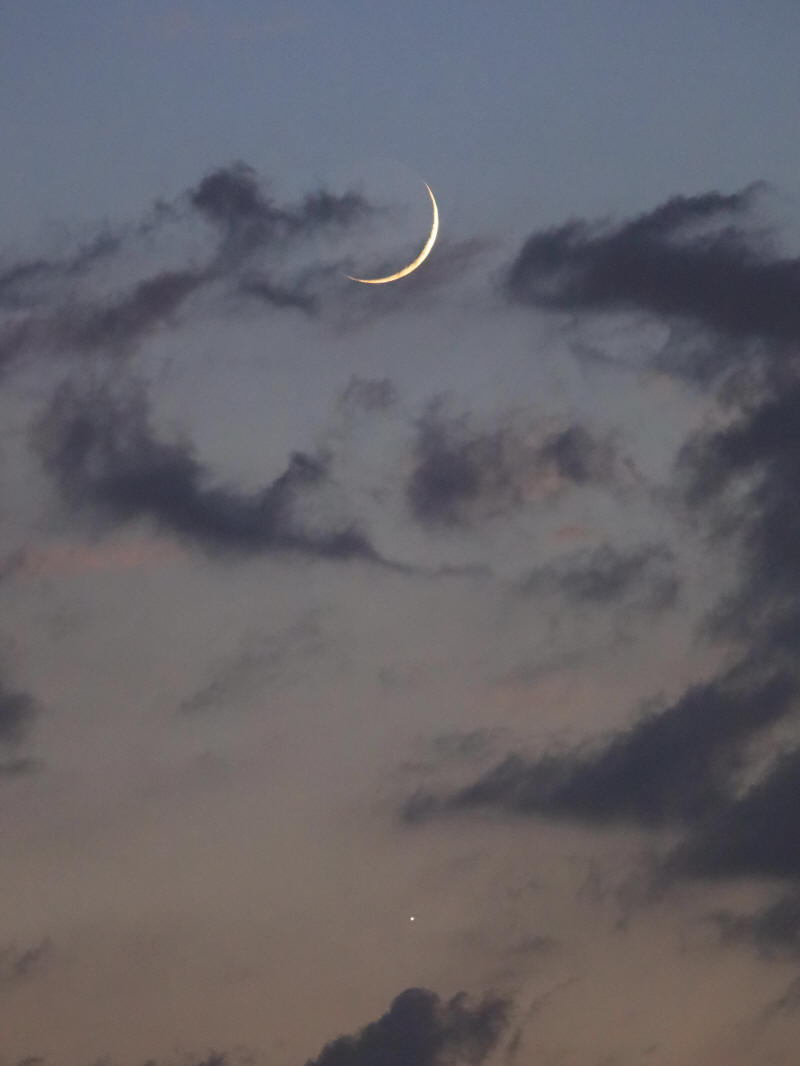
|
On
July 7, 2024, the
2.1-day-old, 4.6% illuminated
Crescent Moon was 2.8°
above the planet
Mercury at
9:18 pm EDT when this image of them was captured from Collins
Lane Park in Maple Shade, NJ. Taken with a Canon RP DSLM camera
and a Canon 400 mm, f/5.6L telephoto lens on a fixed tripod. It
was automatically exposed 1/25 second at f/5.6 , ISO 12,800
using 4800 K white balance (the directly illuminated crescent is
greatly overexposed). The only processing was a little
boost in Mercury's brightness, and cropping this portrait
orientation to a 3:4 ratio for a field about 3.2° wide x 4.2°
high. Mouseover for labels. |
The Young Crescent Moon
Bishops Gate,
July 6, 2024
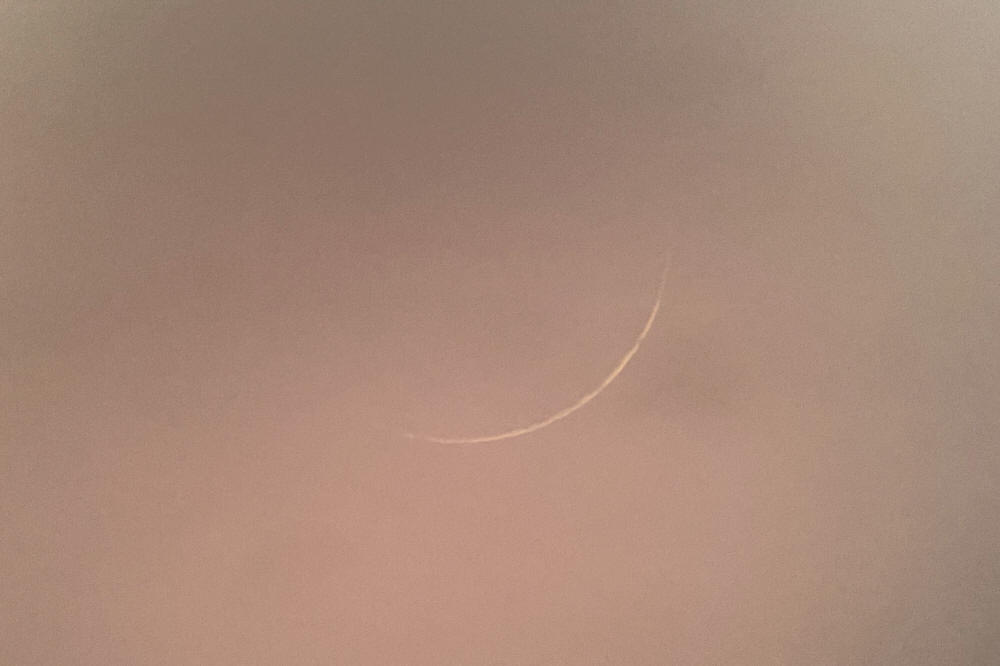
|
On
July 6, 2024, I went to
Bishops Gate in Mt Laurel, NJ, to look for the planets Venus & Mercury, comet
13P/Olbers and the young
Crescent Moon. New Moon
was on July 5 at 6:57 pm EDT, so at sunset on July 6, 8:32 pm,
it would be 25 hr 35 min old. Arriving a little late, I spotted
Venus just
above the distant treetops at 8:44 pm with 12x50 binoculars. One
minute later with the 12x50s, I found the sublimely thin lunar crescent
4½° above Venus when it was just 25 hr 48 min old and 1.3%
illuminated. At 8:56 pm, I spotted
Mercury with the 12x50s about 10° from the Moon at
the 10 o'clock position. As twilight deepened (but thin clouds
were increasing), I found comet
13P/Olbers at 9:37 pm with my
35x115 spotting scope. In the meantime, I checked Corona
Borealis with the 12x50s; I could see all the stars that make up
the constellation's semi-circular stick figure, but there was no
sign of the recurrent nova, T CrB.
This snapshot of the thin crescent was taken at 9:04 pm when the
Moon was 26 hr
07 min old and 4.8° altitude, afocally through one eyepiece of the bino viewer on the 35x115
spotter using a handheld iPhone 11. It was exposed 1/30 second
at f/1.8, ISO 800. The only processing was cropping and a slight
adjustment of the color balance. |
Thompson's Beach
July 1, 2024
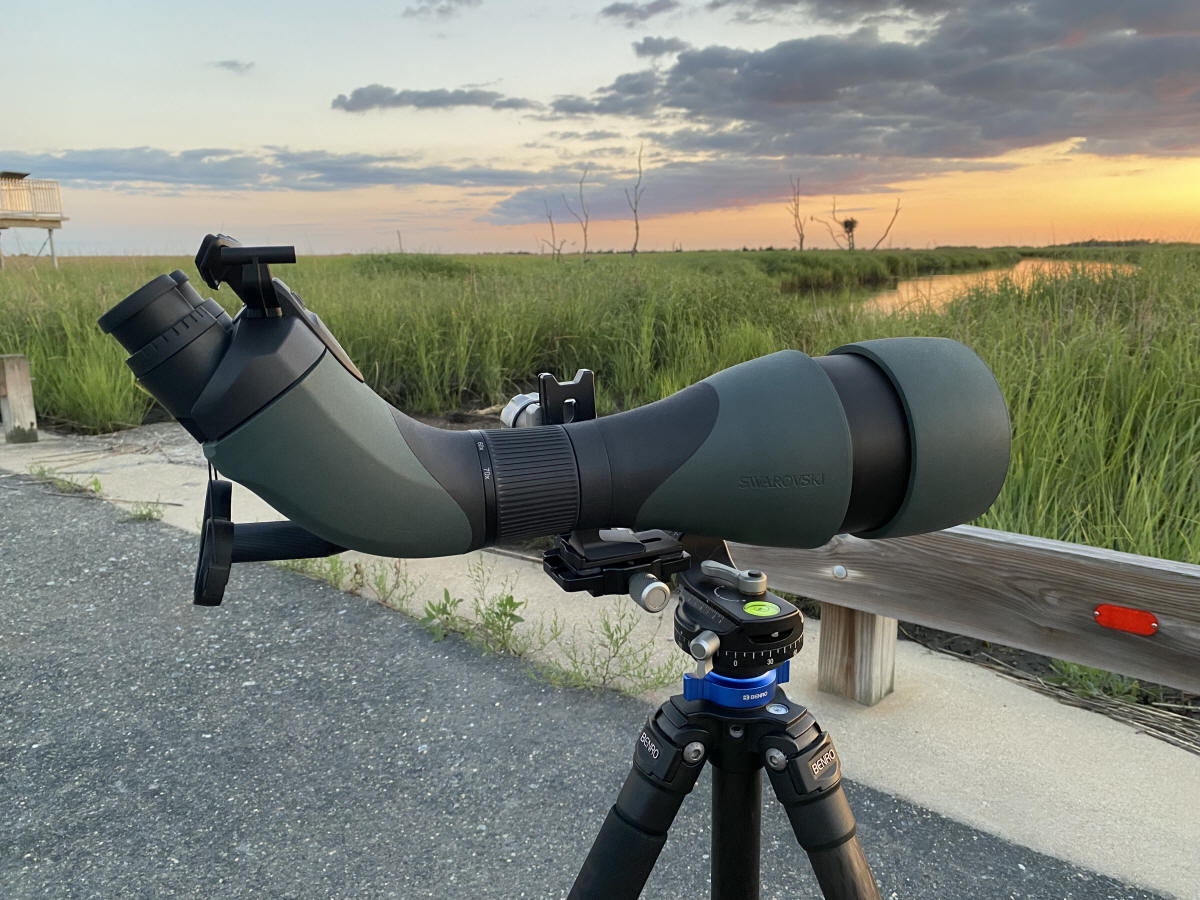
|
On
July 1, 2024, I went to the parking lot of the
nature observation platform at Thompson's Beach, NJ, on the
north shore of the Delaware Bay, about 2 miles east of East
Point and the Maurice River Cove. My primary objective was to
spot Venus, Mercury and comet 13P/Olbers, and to follow-up on
the recurrent nova, T Coronae Borealis. These observations were
successful, starting with Venus at 8:29 pm EDT, a minute before
sunset. Before that, and continuing during twilight, I used my
Swarovski 115 mm (4.5 inch) spotting scope with the 35x
binocular eyepiece module to observe the Osprey over the marsh
on the west side of the parking lot. Ten adults (five pairs)
were seen, including a pair at the nest in the picture above
(plus a chick in the nest) about 100 yd away. They were a
splendid view in the scope. The birds are evidently accustomed
to nearby humans as I could periodically see the adults closing
they eyelids to take a nap. I discovered they (the adult and the
chick) defecate the same as the Bald Eagles (adult and
fledgling) back home in their nest on the cell phone tower at
the Pennsauken Country Club (link at the top of the page).
This snapshot of the scene, looking west-southwest, was taken at 8:30 pm with a handheld
iPhone 11. The scope's objective is to the right, with the
sliding lens hood extended, The ribbed section near the middle
is the focuser (it focuses like a typical telephoto camera
lens). The 35x binocular eyepiece module is at the left end. I
also have a 30 to 70x zoom eyepiece module (they attach via a
bayonet mount) . The top of the this module includes a forehead
rest and a short aiming tube (which I don't often use,
especially after dark). Dangling below is the lens cover (mouseover
for a view from the rear). The scope is mounted on a Foto-Pro
gimbal head, the vertical arm of which can be tilted for better
access to high elevations. As shown, it's at the 45° setting, so
I can tilt the scope enough to observe the zenith. The mount
sits on a heavy-duty Benro carbon fiber tripod. |
The Moon and a pair of Moon Dogs
Bishops Gate, June 20, 2024
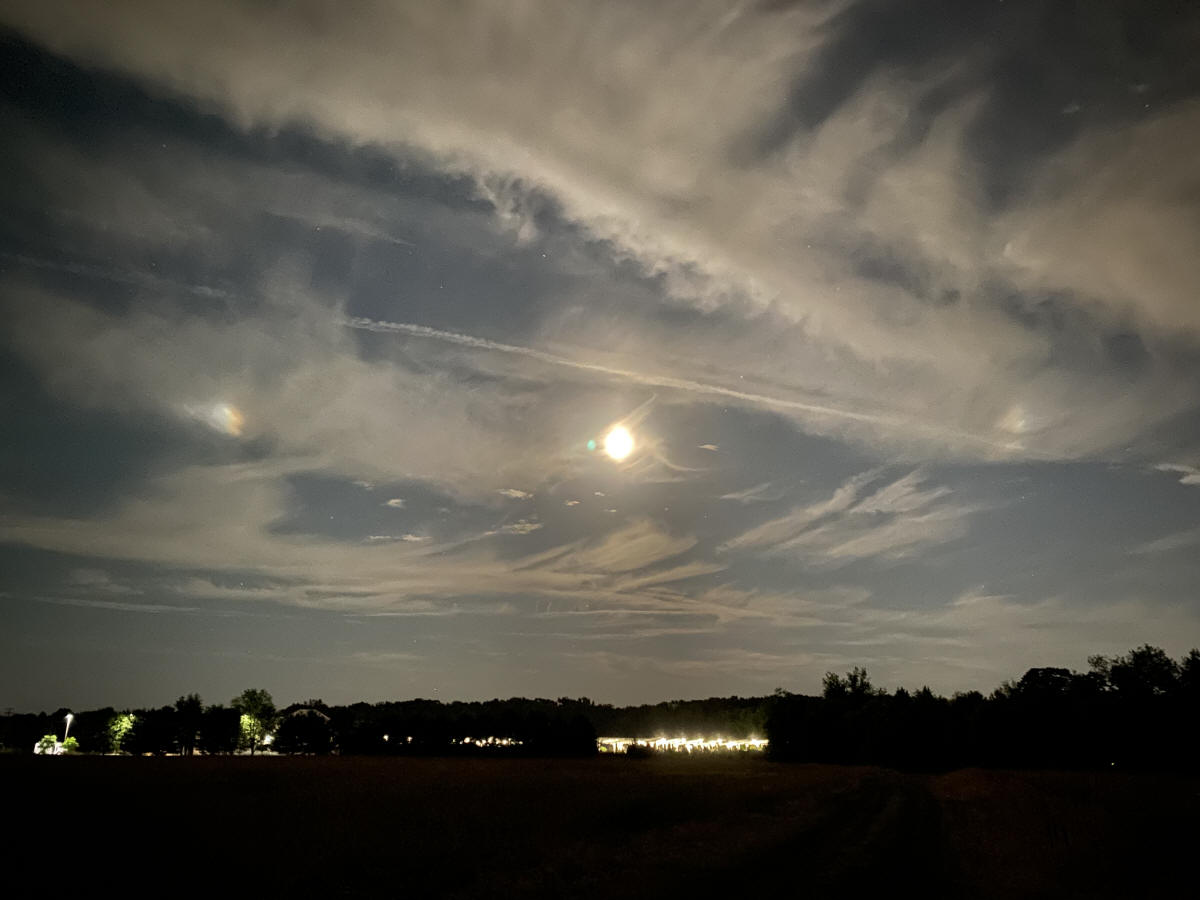
|
On
June 20, 2024, I went to the field at Bishops
Gate in Mt Laurel, NJ, to look for comet
13P/Olbers.
Unfortunately, clouds along the northwestern horizon foiled that
attempt, but about 10:30 pm EDT, as I sat under the open
hatch at the back of my car facing southeast, I saw the
nearly-full
Moon
(it would be full at 9:08 pm on June 21). Then I noticed a
Moon Dog
(paraselene)
in a cloud to the right of the Moon. Shortly after, as another cloud
moved into position, a second Moon Dog appeared on the left, so
a pair of Moon Dogs (paraselenae) flanked the Moon, 22° on
either side (checked with an
outstretched thumb and little finger). Mouseover for labels.
This snapshot of them was captured at 10:34 pm with an iPhone 11
handheld while resting atop my spotting scope, which in turn was
locked in place via its mount on a tripod. The EXIF data
indicated it was exposed 1/2 second at f/1.8, ISO 1000 (although
the exposure period was clearly longer than 1/2 second). Except
for size reduction, no processing was applied or
adjustments made. The turquoise dot left of the greatly
overexposed Moon is an internal camera reflection.
The star well above and a little left of the Moon is second
magnitude Sabik (Eta Oph). To the right of the Moon, and a
little higher in the contrail shadow, is first magnitude Antares
(Alpha Sco).
At the time, the Moon was 14.6 days old, 99% illuminated, 18.3°
altitude, 158° azimuth (SSE) in the very southern part of the
constellation
Ophiuchus (just east of a line between M19 and M62).
The Moon's ecliptic latitude was –5.4°, about as far
south as it gets, so it would transit (12:13 am on June 21) at
just 21.7° altitude for this nominal 40°N-75°W location. |
Click here
for the previous page.
Click here
for an index to all previous SJAstro pages.
























